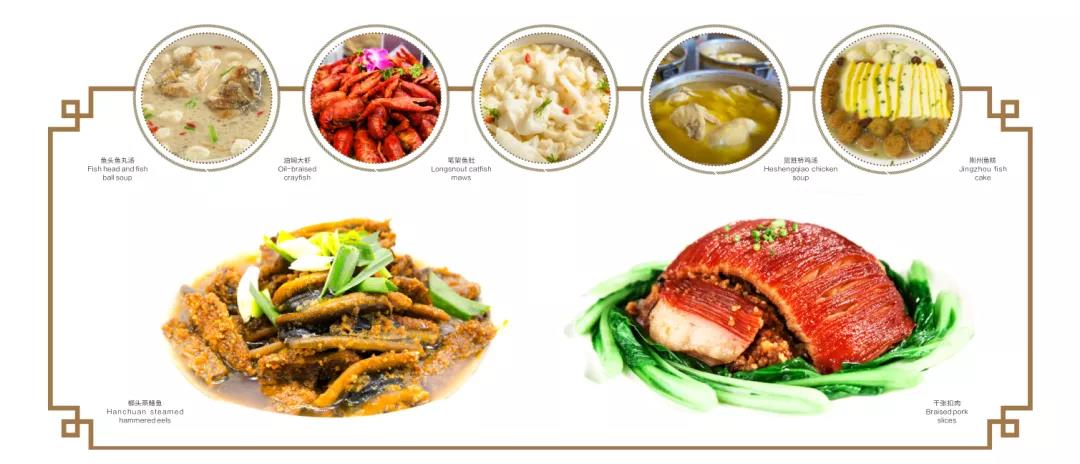
湖北菜,简称楚菜,是中国的主要菜系之一。数千年来,湖北人发明了成千上万种烹调美食的方法——煎、蒸、炖、烤、腌、泡,不一而足。湖北美食品种丰富,几乎每座城市都有它的独特味道,各种味道相互融合,构成了如今令人回味无穷的“楚菜”。
Hubei cuisine is one of the main genres of cuisine in China, called“Chucai.” Through thousands of years of living and creation, Hubei people have developed thousands of ways to cook wonderful dishes—frying, steaming, stewing, roasting, salting, pickling, etc. Hubei cuisine is rich and diverse. Almost every city has its special flavor, and all the flavors mix with each other to make the splendid“Chucai.”
01
潜江大虾扬四海
Qianjiang Crayfish,Popular Home and Abroad
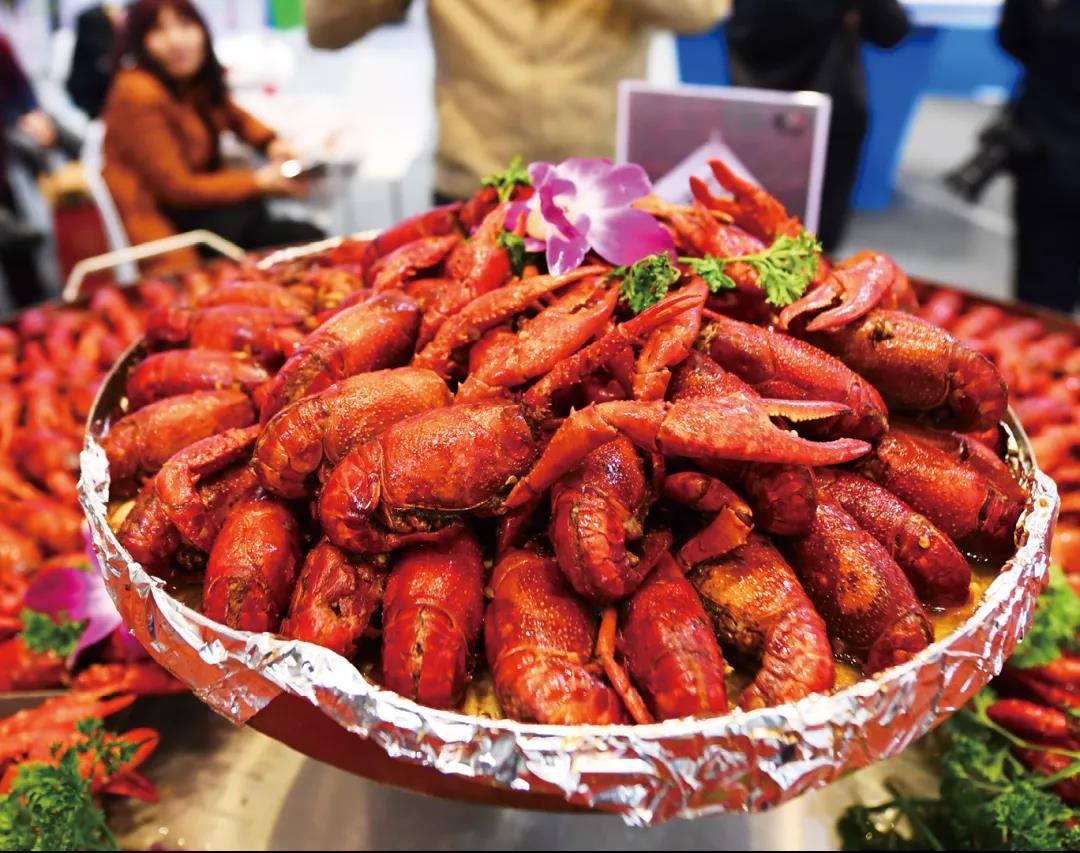
油焖大虾|Oil-braised crayfish
江汉油田工人发现小龙虾油焖加工很好吃后,“潜江油焖大虾”逐渐传开。
By chance workers in the Jianghan Oilfields found that the oil-braised crayfish tasted delicious. The name of“Qianjiang Oil-braised Crayfish” soon went viral in the local community.
潜江人与新加坡、瑞典、德国、挪威等国商家合作,办起了以加工小龙虾产品为主的水产企业,从此小龙虾产业链逐渐发展延伸,成为今天湖北省产值过千亿的特色企业。
Businessmen in Qianjiang initiated cooperation with their counterparts from Singapore, Sweden, Germany, and Norway to set up enterprises mainly dealing in processing crayfish products. Since then, the crayfish industry here has gradually developed, expanded, and finally formed a pillar industry with an annual output value of over 100 billion yuan in Hubei Province today.
潜江龙虾出口欧美,深受国内外大众喜爱。随着高铁开通,每年潜江龙虾节期间,都有大量国内外游客前来尝鲜。
Popular among local and overseas customers, Qianjiang crayfish are exported to European and American markets. In addition, the opening of high-speed railways enables tourists from all over the world to come to Qianjiang during the Qianjiang International Crayfish Festival, which is held annually.
〓潜江国际龙虾节期间,各国来宾大快朵颐
Foreign guests tasting crayfish of different flavors in Qianjiang International Crayfish Festival
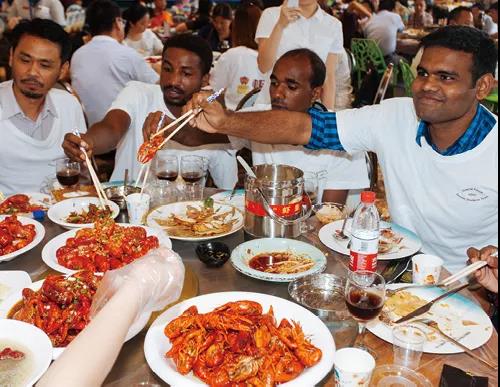
02
桂花绽放品蟹鲜
A Taste of Crabs in Autumn
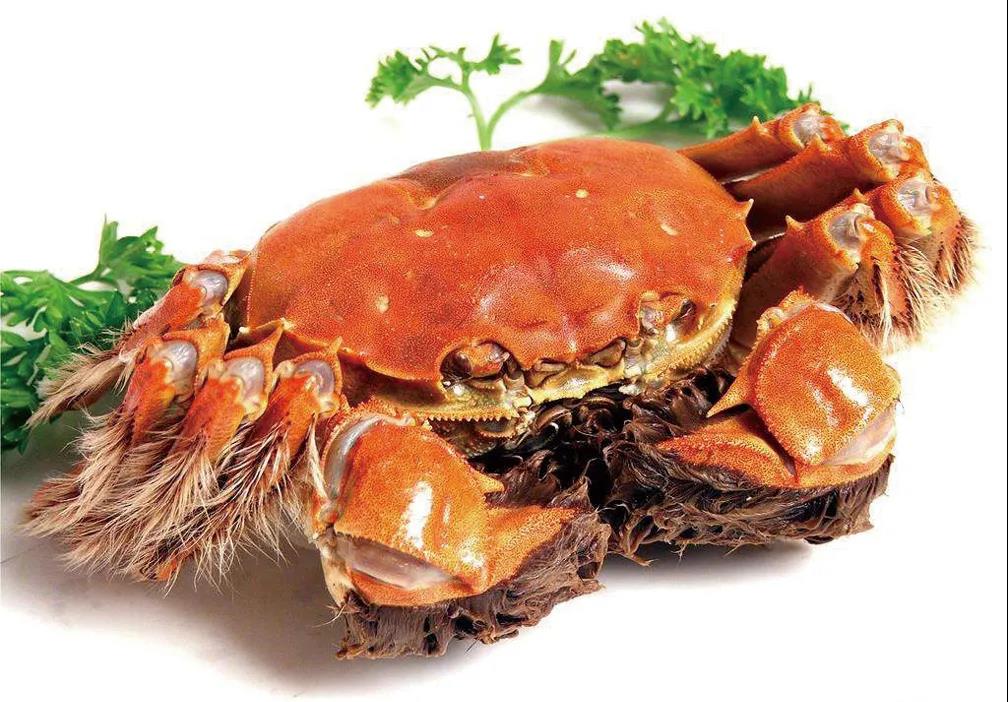
清蒸大闸蟹|Steamed hairy crab
吃螃蟹是中国长江以南省区的生活习惯,尤以江苏、湖北、福建、广东为甚。随着螃蟹营养价值被发现,吃螃蟹已经成了全中国人的爱好。
Eating crabs is a cultural staple of the provinces south of the Yangtze River in China, especially in Jiangsu, Hubei, Fujian, and Guangdong. Because of the nutritional value of crabs, eating crabs has become a trend among Chinese people.
湖北诸多湖泊都生长螃蟹,数洪湖和梁子湖的大闸蟹最鲜嫩可口。
Crabs breed in many lakes in Hubei Province. The hairy crabs in Honghu Lake and Liangzi Lake are the most fresh, tender, and palatable.
公蟹全年可食,母蟹则要到中秋桂花绽放之后吃才鲜美,营养价值最高。
The male crabs are edible all year round whereas the female crabs are more delicious, with the highest nutritional value only after the Mid-Autumn Festival when the sweet-scented osmanthus blossoms are in full bloom.
到梁子岛上吃螃蟹是秋游的绝佳选择。
Eating crabs on Liangzi Island is the best choice for an autumn outing.
〓香辣蟹
Fried spicy and fragrant hairy crab
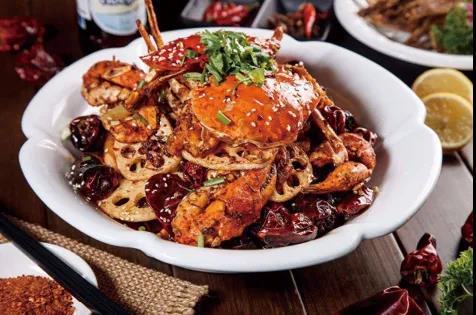
03
千年名肴武昌鱼
Wuchang Fish, a Famous Traditional Dish
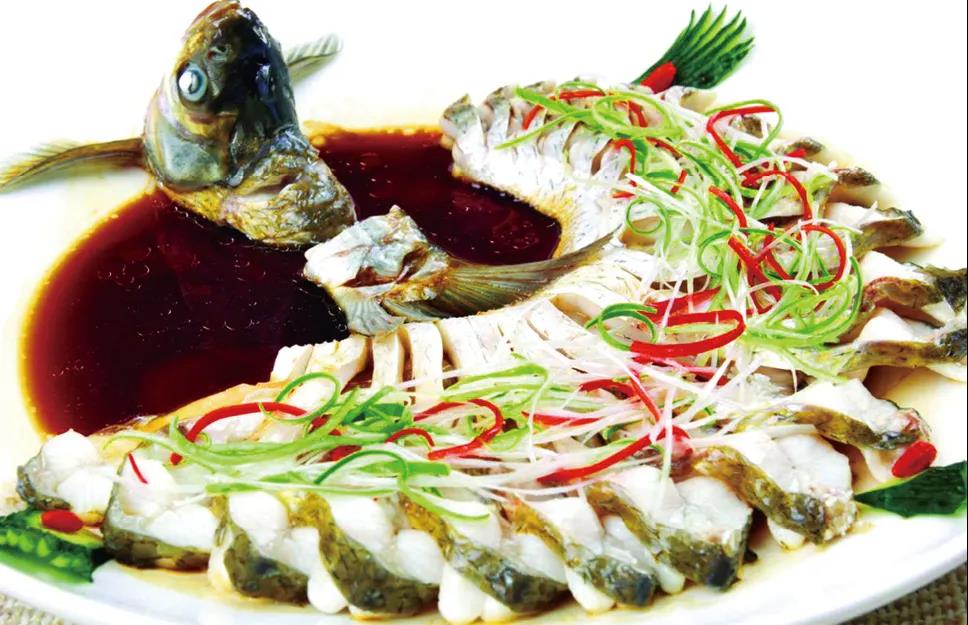
清蒸武昌鱼|Steamed Wuchang fish
武昌鱼肉质鲜嫩肥美。有几种鱼很像武昌鱼,行家一般能通过它们的肋骨数量判断真伪。清蒸是最能保持肉质鲜美的做法。
Wuchang fish is one of the famous traditional products of Wuhan City. Known as“Tuantoufang” (blunt-snout bream), it is a kind of bream originally produced in the Liangzi Lake of Ezhou City in Hubei Province. Its meat is nutritious, tender and tasty. There are other kinds of fish similar to Wuchang fish. Experts can tell the difference by counting their ribs. Steaming is the best cook method to keep its nutrition.
关于武昌鱼的故事很多,名人更多。早在三国时期(1700多年前),武昌鱼就已饮誉天下。除了红烧肉,毛泽东也喜欢吃武昌鱼,还写下了“才饮长沙水,又食武昌鱼”的名句。
Wuchang fish has a long history and many anecdotes related to celebrities. It is said that Wuchang fish got its name during the Three Kingdoms period 1700 years ago. Apart from stewed pork, Mao Zedong likes to eat Wuchang fish. In one of his poems, Mao Zedong said with pleasure,“I have just drunk the water of Changsha/ And come to relish the Wuchang fish.”
武昌鱼常年都有。不吃武昌鱼,跟不游黄鹤楼一样,不算到过武汉。
Wuchang fish can be eaten all year round. Just like mounting the stairs up the Yellow Crane Tower, everybody who comes to Wuhan should have a taste of this fish, if not he will leave with great regret.
04
湖北藕宴外宾爱
A Special Dinner of Lotus Root
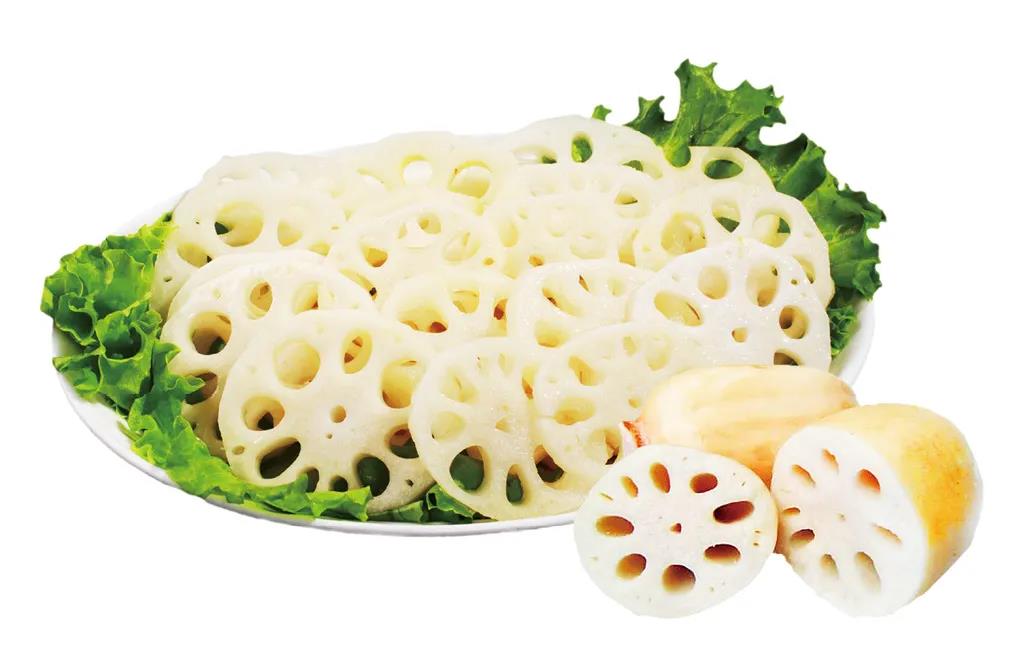
藕片|Sliced lotus root
中国养生经中有一种说法:“男不离韭,女不离藕。”湖北是千湖之省,藕是当地重要的水产资源。排骨藕汤虽算不得名贵大菜,却是湖北乃至整个长江流域人们最爱吃的菜。
There is a saying in the Chinese Health Sutra that“Men should often eat leek, and women should eat lotus root.” Hubei is a province of thousands of lakes, and lotus root is an important part of its aquatic resources. Although lotus root and rib soup is not an expensive dish, it is the most popular in Hubei and even the whole Yangtze River basin.
2018年7月的一个周五,留学于华中师范大学的肯尼亚博士生拉费尔,带着他的非洲兄弟以及来自哥斯达黎加、马拉维等国的留学生来到东湖之滨,专程享用了一席特殊的藕宴:炸藕夹、荷塘三宝、冰镇莲子米、酸辣藕丁、泡藕带炒牛肉,当然还有排骨藕汤。
On a Friday in July 2018, Raphael Ziro, a Kenyan doctoral candidate at Central China Normal University, brought his African brothers and schoolmates from Costa Rica, Malawi and other countries to a restaurant close to the East Lake. There they enjoyed a special dinner mainly consisting of dishes made from lotus roots such as fried lotus root slices, lotus-pond three treasures, iced lotus seeds, sour and spicy lotus root dices, pickled lotus shoots with fried beef, and of course, lotus root and rib soup.
大家都觉得藕好吃,拉费尔甚至抱着新鲜的藕节就想咬一口。大家一致认为,藕这么好,要是能在自己的国家种就好了。
Everyone thought the lotus root was delicious. Raphael even wanted to take a bite of the fresh lotus root. Everyone agreed that lotus root was so good that they would like to have it in their own country.
〓排骨藕汤
Lotus root and rib soup
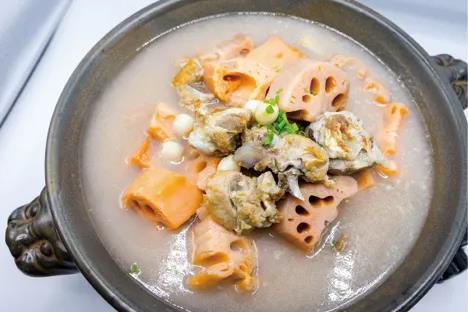
05
金殿玉菜有菜薹
Hongshan Caitai, Jade Cuisine of Imperial Palace
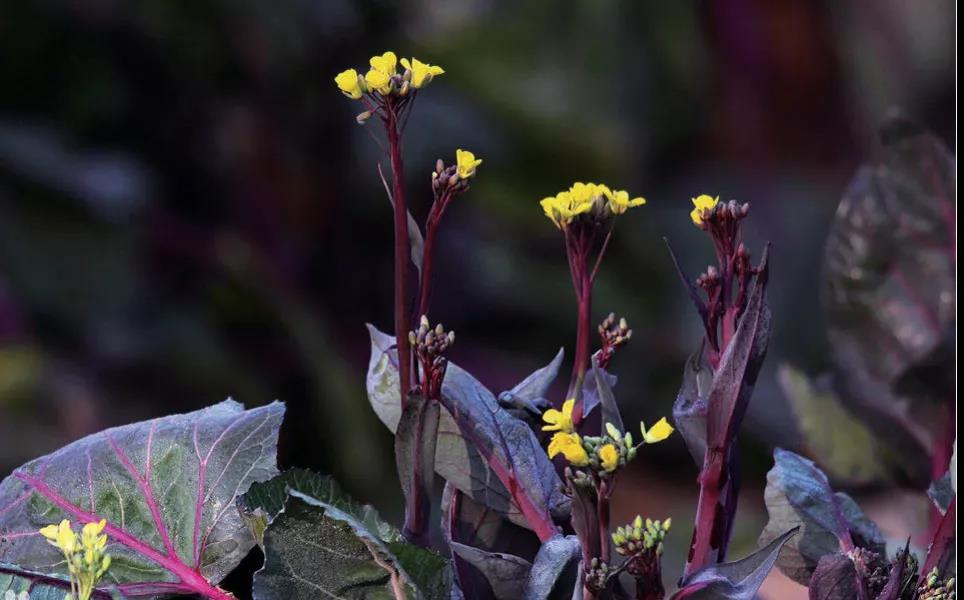
菜薹|Caitai
湖北土地肥沃,水分充足,气候适宜,特别适合种植菜薹。冬天吃菜薹是湖北人的习惯,已有2000多年历史。
Hubei, located on a fertile land plentiful in rainfalls and mild in climate, is suitable for planting vegetables. Caitai, a flowering Chinese cabbage, is a specialty that locals enjoy in winter, which is a tradition that may have lasted for some 2000 years.
宝通禅寺钟声影响范围内的最有名,这里的菜薹一般比市场上的贵上百倍。
Hubei grows the finest caitai in China, and the best in Hubei is that planted close to Baotong Temple in Hongshan District of Wuhan. It is named“Hongshan caitai” after its place of origin. As if influenced by the tolling of the bell in the Temple, the caitai planted here is especially tasty and favored in the market, enjoying a price often hundreds of times higher than others on the market.
湖北菜薹被历代皇室定为贡品,封为“金殿玉菜”。唐代杨贵妃快马送荔枝,清代慈禧太后快马传菜薹。
Hongshan caitai was formerly designated as a court tribute and favored by the royal families, and got the name of“Jade Cuisine of Imperial Palace.” Fresh litchi was delivered to Concubine Yang in the Tang Dynasty, daily by horseback from the south, while Hongshan caitai was sent to Empress Dowager Cixi of the Qing Dynasty by galloping steed.
传说北宋大诗人苏东坡也是菜薹的一大粉丝,曾经三度来汉,只为尝一口洪山菜薹。
It is said that Su Dongpo, a great poet in Song Dynasty, was also a great fan of caitai. He had visited Wuhan three times just for a taste of Hongshan caitai.
〓菜薹炒腊肉
Fried caitai with Chinese bacon
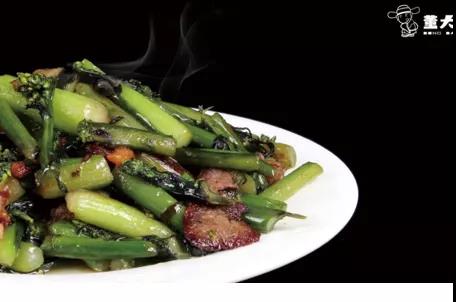
06
湖北鱼丸急出来
Fish Balls, an Invention by Accident
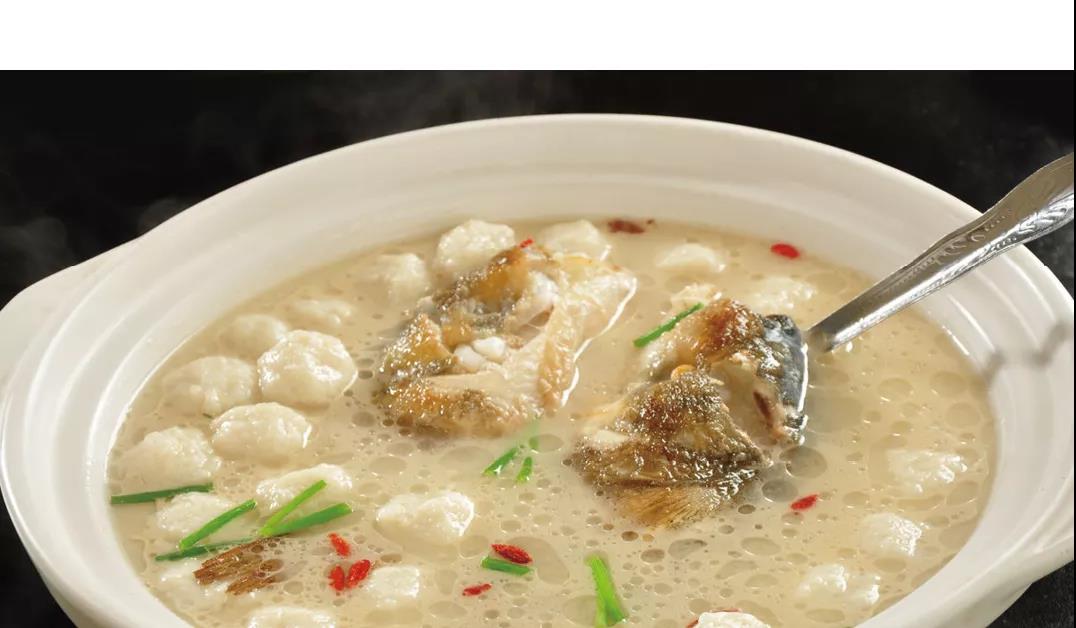
鱼头鱼丸汤| Fish head and fish ball soup
湖北被称为“鱼米之乡”,鱼的吃法千变万化,鱼丸是最普遍的做法之一。鱼丸的做法是偶然发明的。
Hubei is known as a“Land of Fish and Rice.” Here, fish can be cooked in various ways, and fish balls are one of the most common dishes. This method of fish cooking was actually invented accidentally.
楚文王(2700多年前在位)喜欢吃鱼,但总被鱼刺扎喉,为此杀了不少御厨。有一天,一名御厨面对死亡恐惧,愤怒之下,用刀背猛拍眼前的鱼块。
King Wen of Chu (who reigned more than 2700 years ago) liked eating fish, but he would always get fish bones stuck in his throat, for which he killed many imperial cooks. One day, an imperial chef, faced with the fear of death, smacked the fish with the back of his knife.
奇迹发生了,鱼刺受力后,从鱼肉中挤出来,他忙把刺和肉分开,并将肉揉成团投入沸水中做成汤呈上。没想到文王龙颜大悦,下令将此菜定为“国菜”并重奖御厨。此后,鱼丸成了历朝历代的御膳珍品。
At this point the miracle occurred. After the fish meat was stressed, the bones were squeezed out of the meat. He at once separated the spine from the meat, rolled the meat into a ball and put it into the boiling water to make soup. As luck would have it, King Wen was delighted and decreed that this dish be designated as a“national dish” and rewarded the imperial cook bounteously. After that, fish balls became a royal food in all the following dynasties.
07
沔阳一绝数蒸菜
Steamed Dishes, a Specialty in Jianghan Plain
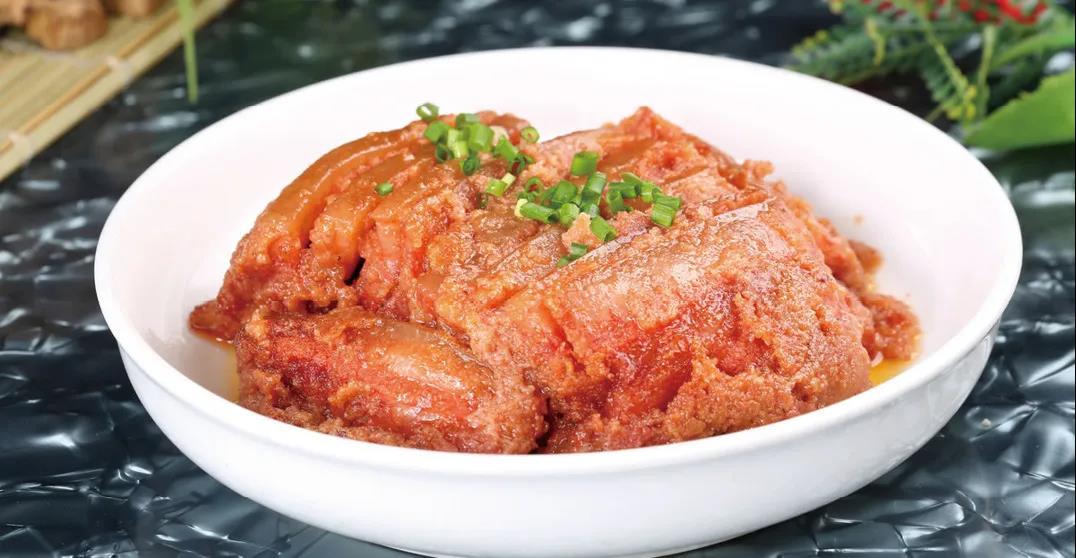
粉蒸肉|Steamed pork with rice flour
吃蒸菜是湖北民间重要的饮食习惯,尤以江汉平原沔阳(今仙桃市)一带为盛,几乎所有的菜都可以蒸着吃。蒸茼蒿、蒸芋头、蒸南瓜、蒸鳝鱼、蒸肉、蒸排骨……天门市每年都举办蒸菜节,让游客大开眼界,一饱口福。
Steamed dishes are popular among folks in Hubei Province, especially in Mianyang (now Xiantao) and other cities in the Jianghan Plain. Almost everything edible can be steamed. Common dishes include steamed artemisia, steamed taros, steamed pumpkins, steamed eels, steamed pork, and steamed ribs. A Steamed Cuisine Festival is held annually in Tianmen City, which allows tourists and food lovers to enjoy delectable steamed foods.
〓沔阳三蒸
Mianyang three steamed dishes
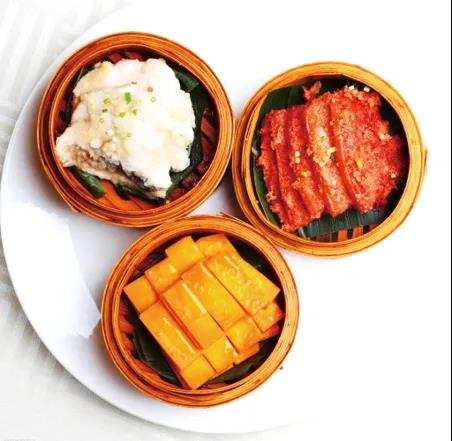
08
黄酒就面人人爱
Xiangyang Beef Noodles with Huangjiu, a Good Choice for Breakfast

襄阳牛肉面|Xiangyang beef noodles
游客到襄阳,襄阳牛肉面总是要品的地方一绝。对襄阳人来说,襄阳牛肉面就像云南人喜欢吃的过桥米线一样。每天早餐,襄阳人都要吃襄阳牛肉面。通常,人们在吃面时,还要喝一碗黄酒。
For visitors to Xiangyang City, Xiangyang beef noodles are a local specialty that no one should miss. Xiangyang beef noodles to Xiangyang citizens are just like crossing-the-bridge noodles (guoqiao mixian) to Yunnan citizens. Everyone eats it for breakfast. Usually people drink a bowl of huangjiu (yellow rice wine) or two when having the noodles.
早上请吃襄阳牛肉面是当地人的一种习惯。不过,如果你不喜欢吃辣的话,最好先跟师傅讲一声。
To invite people to eat Xiangyang beef noodles for breakfast is a custom in this city. But if you don’t eat spicy food, you’d better mention it beforehand.
〓朋友相聚,更饮一杯
Old friends toasting with rice wine to each other
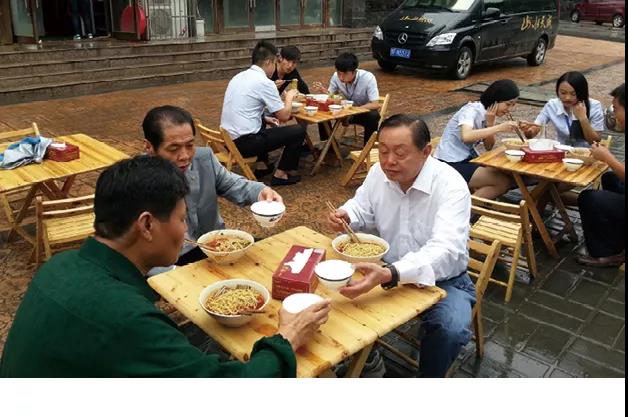
09
湖北火锅吊起来
Hubei Hotpot, Hung over Charcoal
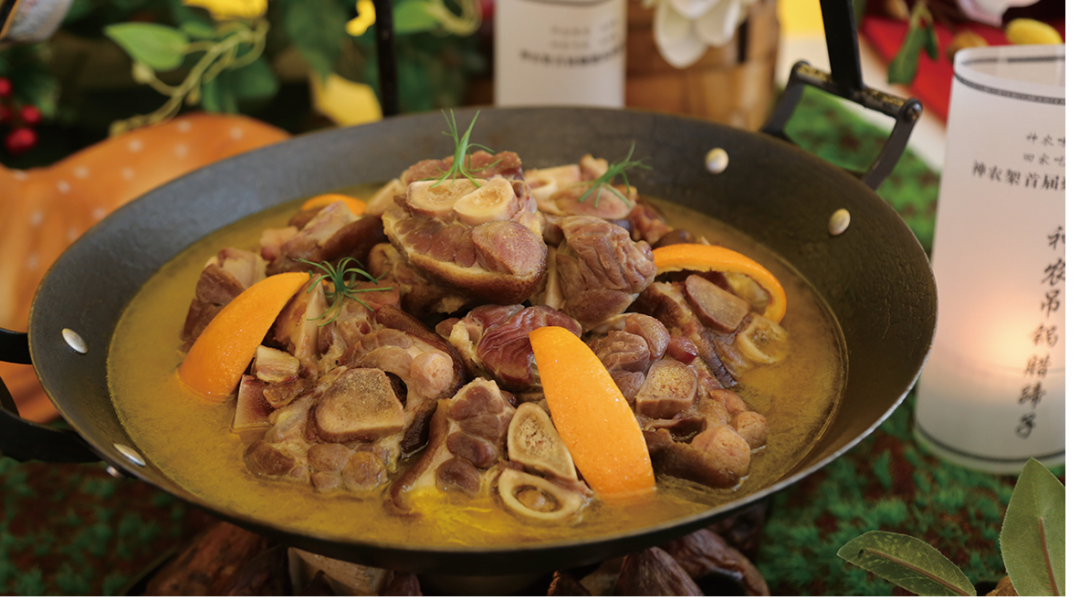
腊蹄子火锅|Salted pig feet hotpot
吃火锅在湖北很盛行。火锅一般以炖肉为主,羊肉、牛肉、鱼肉、鸡肉等等,都是火锅主料。土家人喜欢吃腊蹄子火锅,常常是家宴的主菜。与重庆火锅不同,湖北火锅多数是吊锅,用木炭而不是煤气或电加热。锅中肉吃完,人们通常就汤下菜,如豆腐、白菜、蒜苗等,味道也挺好。
Hotpot is also popular around Hubei. It is commonly used to stew meat, like mutton, beef, fish, chicken, and so on. Tujia people like to eat salted pig feet hotpot. It is usually served as the main dish during dinner. Different from the style of Chongqing hotpot, Hubei hotpot is heated by hanging the pot over charcoal instead of gas and electricity. After the meat has been eaten, people usually add some vegetables, like tofu, cabbage, garlic, etc., into the soup and stew them to be eaten once cooked.
10
养生米酒孝感酿
Xiaogan Rice Wine Benefits Our Body
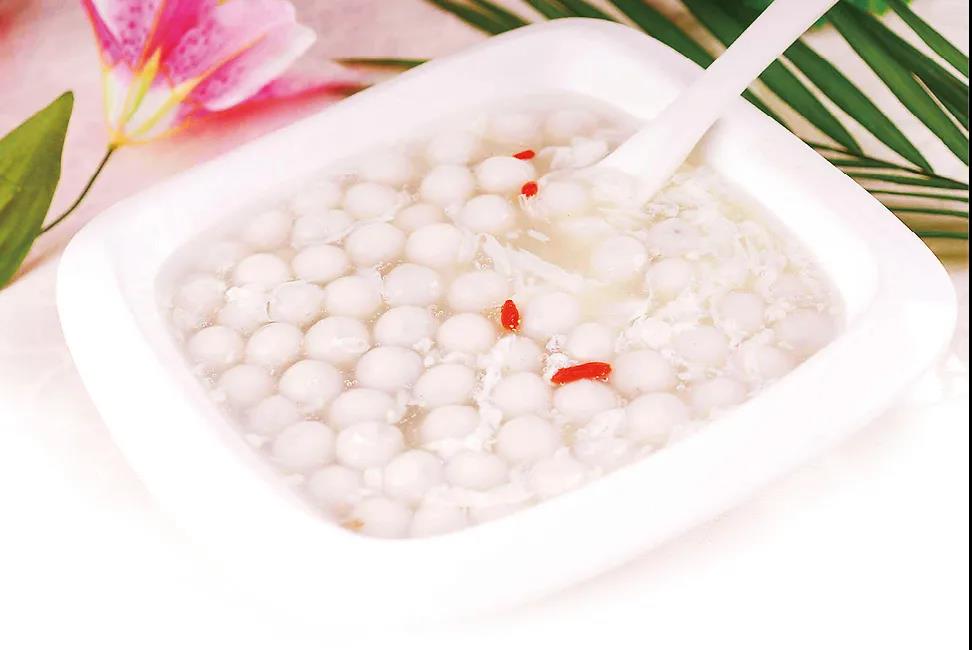
孝感米酒煮汤圆|Glutinous rice balls in Xiaogan rice wine soup
湖北人喜欢喝米酒,甚至家家都会做米酒,而以孝感米酒最为出名。孝感米酒以优质朱湖糯米为原料,用孝感特制酒曲——蜂窝酒曲经糖化发酵制成,汤色玉白,蜜香浓郁,入口甜美,富含硒、锌、铁、葡萄糖、氨基酸等营养成分,开胃提神,活血养气,滋阴补肾,老少皆宜。宋太祖赵匡胤曾连干三大碗,毛泽东也夸奖“味好酒美”。需要注意的是,米酒糖分含量高,糖尿病患者慎食。
People in Hubei are fond of drinking rice wine—so much so that almost every family can make it. The rice wine made in Xiaogan is the most famous one in China. Xiaogan rice wine is made of high-quality local glutinous rice fermented with a special honeycomb distiller’s yeast. The liquor looks white and tastes sweet with a rich honey flavor.
The rice wine is appetizing, refreshing, and nourishing. High in nutrients such as selenium, zinc, iron, glucose, and amino acids, it is suitable for people of all ages. What’s more, it can promote blood circulation, cultivate one’s vitality and benefit one’s kidneys. Zhao Kuangyin, Emperor Taizu of Song, once drank three bowls of Xiaogan rice wine at a meal. Mao Zedong once praised it as a delicious wine. It should be noted that rice wine has a high sugar content, so diabetic patients should abstain from drinking too much of it.

